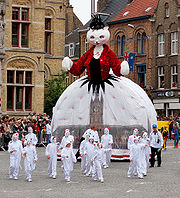
Kattenstoet
Encyclopedia

Ypres
Ypres is a Belgian municipality located in the Flemish province of West Flanders. The municipality comprises the city of Ypres and the villages of Boezinge, Brielen, Dikkebus, Elverdinge, Hollebeke, Sint-Jan, Vlamertinge, Voormezele, Zillebeke, and Zuidschote...
, Belgium
Belgium
Belgium , officially the Kingdom of Belgium, is a federal state in Western Europe. It is a founding member of the European Union and hosts the EU's headquarters, and those of several other major international organisations such as NATO.Belgium is also a member of, or affiliated to, many...
, devoted to the cat
Cat
The cat , also known as the domestic cat or housecat to distinguish it from other felids and felines, is a small, usually furry, domesticated, carnivorous mammal that is valued by humans for its companionship and for its ability to hunt vermin and household pests...
. It is held every third year on the second Sunday of May. Most recently, the 42nd edition took place on May 10, 2009.
The parade commemorates an Ypres tradition from the Middle Ages
Middle Ages
The Middle Ages is a periodization of European history from the 5th century to the 15th century. The Middle Ages follows the fall of the Western Roman Empire in 476 and precedes the Early Modern Era. It is the middle period of a three-period division of Western history: Classic, Medieval and Modern...
in which cats were thrown from the belfry
Bell tower
A bell tower is a tower which contains one or more bells, or which is designed to hold bells, even if it has none. In the European tradition, such a tower most commonly serves as part of a church and contains church bells. When attached to a city hall or other civic building, especially in...
tower of the Cloth Hall
Cloth Hall, Ypres
The Cloth Hall , of Ypres, Belgium, was one of the largest commercial buildings of the Middle Ages, when it served as the main market and warehouse for the Flemish city's prosperous cloth industry. The original structure, erected mainly in the 13th century and completed 1304, lay in ruins after...
to the town square below. Symbolically reviving this practice for the parade festivities, a jester tosses plush cats from the Cloth Hall belfry down to the crowd, which awaits with outstretched arms to catch one. The throwing of the cats from the belfry is followed by a mock witch burning.
Participants in the festivities often dress as cats, witches, or townspeople from ages past.
There are various legends about how the throwing of cats originated. One possibility is that cats were connected to witchcraft, and the throwing of the cats symbolised the killing of evil spirits.
Another story suggests that the cats were brought in to the Cloth Hall (Lakenhallen) to control vermin. Before modern heating and storage methods, when it got cold the wool was stored in the upper floors of the Cloth Hall. At the start of the spring warm-up after the wool had been sold the cats were tossed out of the belfry.

